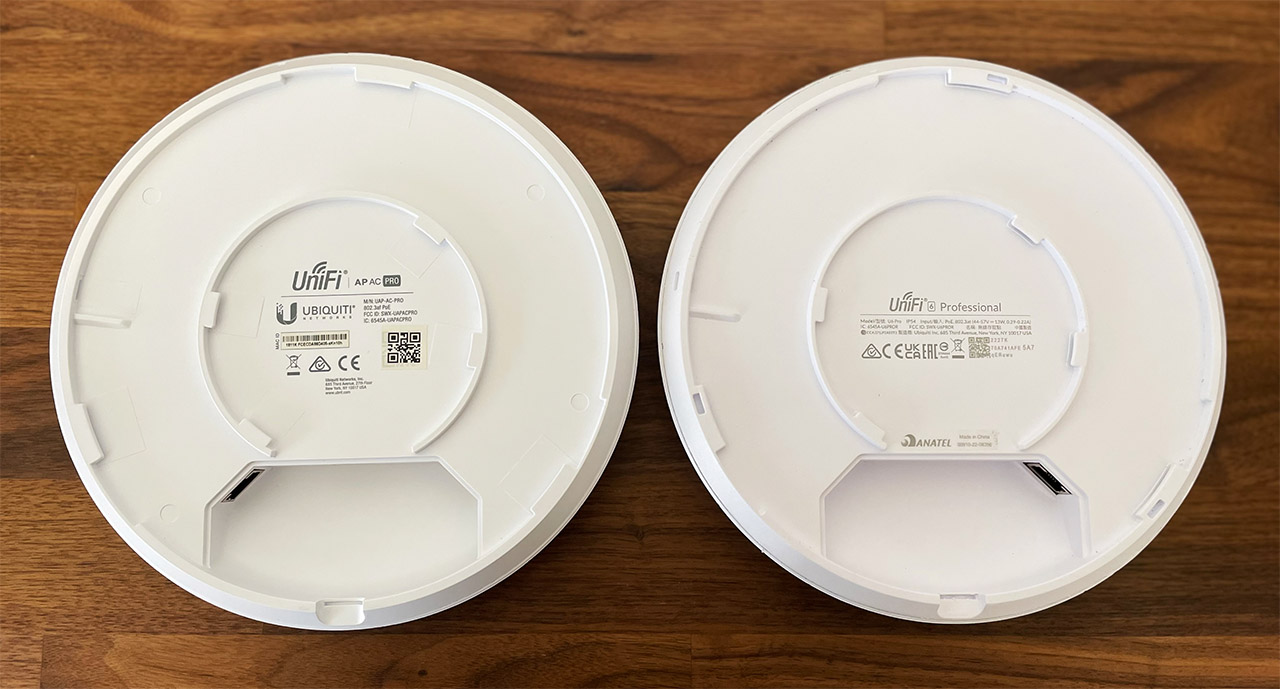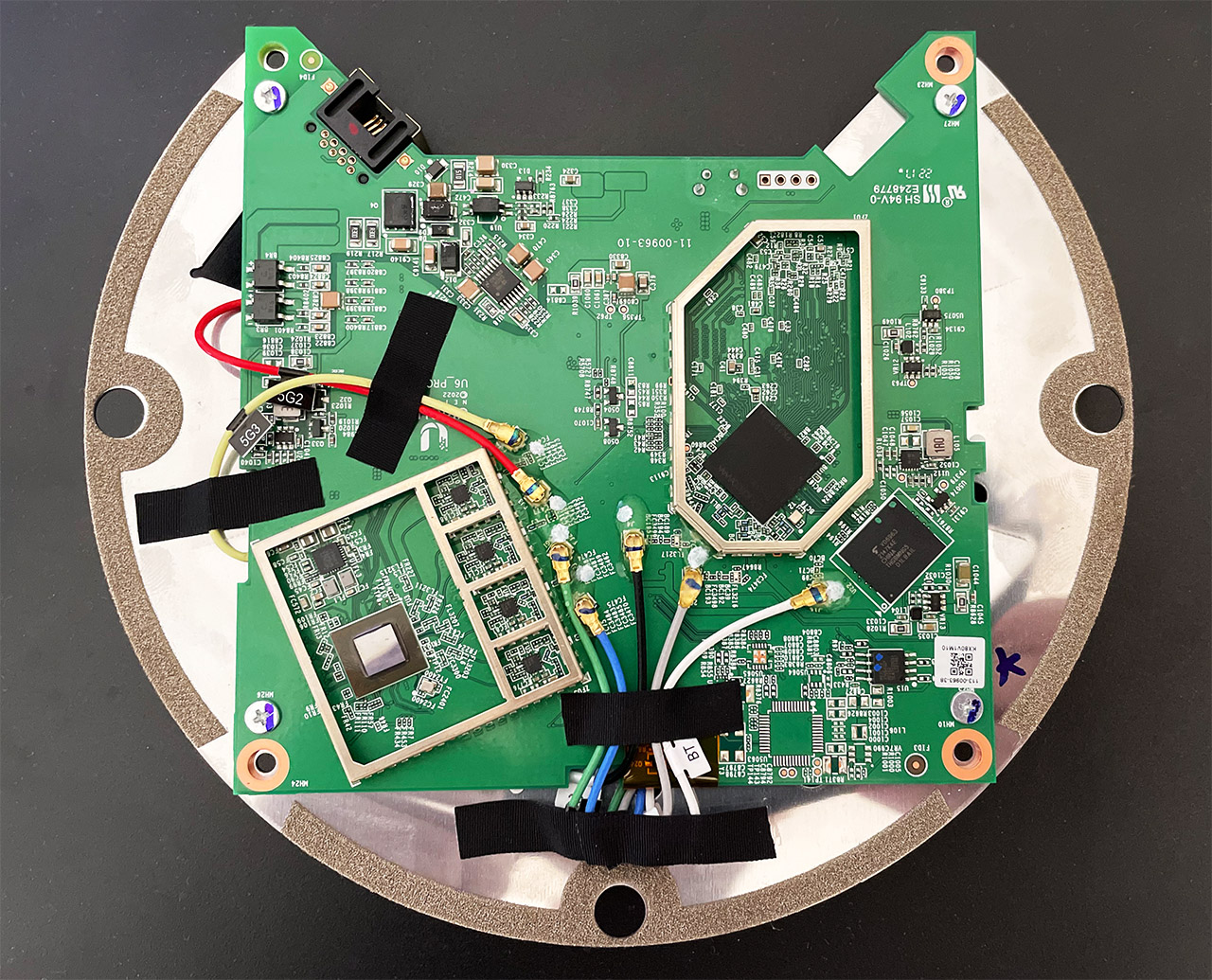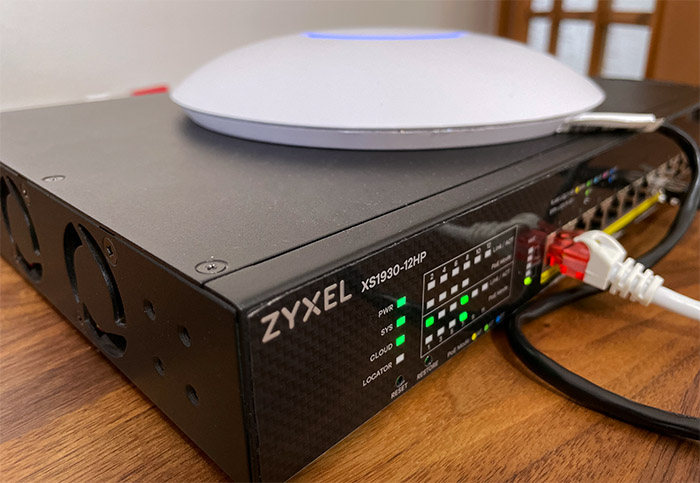Although from different generations of UniFi WiFi 6 access points, the Ubiquiti U6-Pro and the U6-LR are regarded as being very similar by the general public. I have tested both access points and, in some instances, the wireless performance is similar on the 5GHz, but they’re still overall different, especially when the client devices are far away from the units.
Furthermore, the access points are built on different platforms (Qualcomm vs MediaTek), and it was curious to see that the Ubiquiti U6-LR was unable to fully utilize some of the features of the new WiFi standard. The OFDMA was only enabled on the 5GHz radio band – the U6-Pro had no such limitations.
| Ubiquiti U6-LR | |
|---|---|
| Amazon.com | Check Product |
| Ubiquiti U6-Pro | |
|---|---|
| Amazon.com | Check Product |
This can have an impact in areas with lots of access points and client devices, but in most cases, the user would barely see any benefit from OFDMA. It’s worth mentioning that the U6-LR does support a slightly higher transmit power, potentially allowing it to reach farther, offering a better range (then again, LR stands for Long Range).
Other than that, the U6-Pro is also more compact than the U6-LR, but both devices have the same number of ports and yes, unfortunately neither has a multi-Gigabit port. That’s a privilege left to the U6-Enterprise. That being said, let’s put the Ubiquiti U6-Pro next to the U6-LR and see which of the two WiFi 6 access points is the better device.
Note: You can also check out the individual analysis of each WiFi 6 access point here: Ubiquiti U6-LR and Ubiquiti U6-Pro.
Design and Build Quality
Ubiquiti is well known for its iconic saucer-shaped wireless access points and this design has been used for the U6-Pro and the U6-LR as well. But there is a fundamental difference: the size. Ubiquiti got a bit anxious when developing the U6-LR, so it increased the size of the device to 8.66 x 1.89 inches (while the nanoHD was way smaller).

Then, the developers have regained some of the confidence and with the switch to a new architecture (to Qualcomm), the Ubiquiti U6-Pro is a bit smaller, measuring 7.76 x 1.38 inches. There is more because the Ubiquiti U6-LR is entirely made of plastic, relying on internal metallic plates to guide the heat outwards (this way, the case doesn’t get hot to the touch, but more heat remains inside).
The U6-Pro went with a similar approach to the EnGenius ECW220S and it made the bottom section metallic to quickly take the extra heat out, while the top is plastic. Yes, the case will be seemingly hotter, but it doesn’t matter when the device is mounted on the ceiling.
I didn’t leave this to interpretation, so I got the thermal camera out to confirm that indeed, both access points have a good thermal management. The photos speak for themselves.

I have mentioned that the APs will end up on the ceiling, but is it possible to leave them on the desk? No, both the Ubiquiti U6-Pro and the U6-LR are designed to be mounted on the ceiling – you can put them on the wall, but the range will suffer a bit. What about the status LEDs? As with the previous generations, both access points use an LED ring to show the status of the network, connection and the device itself. When the LED is blue, it means that everything is working fine, and it will stay white before you adopt the AP to the controller.
When the LED flashes blue every five seconds, it means that the access point has lost its connection to the network. The curious thing is that Ubiquiti has initially advertised the U6-Pro (and, apparently the U6-LR as well) as having RGB, but they later removed that feature due to supply issues.

The ports are positioned in the same area on both devices, so, if you check the recessed spot on the bottom of the U6-LR and the U6-Pro, you should see a single Gigabit Ethernet port (PoE 802.3af) and a Reset button. That’s it.
I understand that the PoE is the superior option, but I am not a fan of removing additional possibilities, so I would have liked to either see a power connector or a PoE adapter in the package, otherwise how exactly Ubiquiti expects the user to power up its access points?
Lastly, I would like to mention that the Ubiquiti U6-Pro and the U6-LR are IP54-rated, so you could technically mount the devices outdoors, but I would make sure that they’re still not completely in the open since neither are built like actual tanks (I do have an article with proper outdoors access points).

That being said, considering that it’s the smaller device, the U6-Pro is the better built and designed access point.
Internal Hardware (Ubiquiti U6-Pro vs U6-LR Teardown)
I have recently revisited the old Ubiquiti nanoHD which was the first time the manufacturer experimented with the MediaTek platform and it seems that they were confident it would work fine with the Ubiquiti U6-LR as well. And it did up to a point, but they got some issues covering the main WiFi 6 features (OFDMA), so the Ubiquiti U6-Pro uses the Qualcomm platform instead.

Indeed, the Ubiquiti U6-Pro is equipped with a dual-core 1GHz Qualcomm IPQ5018 chipset, 1GB of RAM from Kingston (2x D5128ECMDPGJD) and 4GB of storage memory from Mouser Electronics (THGBMNG5D1LBAIL). Furthermore, the access point uses the Qualcomm IPQ5018 as the chip switch and, as for the WiFi, it relies on Qualcomm QCN9024 802.11a/b/g/n/ac/ax 4×4:4 for the 5GHz radio and the Qualcomm IPQ5018 802.11b/g/n/ax 2×2:2 for the 2.4GHz radio band.

The Ubiquiti U6-LR relies on the dual-core 1.35GHz Mediatek ARM MT7622AV chipset, has a bit less RAM since it’s equipped with 512MB from Winbond (2x W632GU8NB-11) and it sports only 64MB storage from Winbond (25Q512JVFQ). Furthermore, the WiFi 6 access point uses the Marvell AQrate AQR112G switch chip and, as for WiFi, it relies on the Mediatek MT7975AN and MT7915AN 802.11a/b/g/n/ac/ax 4×4:4 chips for the 5GHz radio band and the Mediatek MT7622 802.11a/b/g/n 4×4:4 for the 2.4GHz radio.
Note: A lot of users like to see the maximum theoretical data transfer rate, so here it is. The Ubiquiti U6-LR can go up to 2,400Mbps on the 5GHz and up to 600Mbps on the 2.4GHz radio band. The Ubiquiti U6-Pro goes up to 4,800Mbps on the 5GHz and 573.5Mbps on the 2.4GHz radio band.
| Ubiquiti U6-LR | Ubiquiti U6-Pro | |
| CPU | dual-core 1.35GHz Mediatek ARM MT7622AV | dual-core 1GHz Qualcomm IPQ5018 |
| RAM | 512MB (2X Winbond W632GU8NB-11) | 1GB (2x Kingston D5128ECMDPGJD) |
| Storage | 64MB Winbond (25Q512JVFQ) + 16MB and 512KB from MXIC | 4GB Mouser Electronics (THGBMNG5D1LBAIL) + 8MB MXIC (25U6432F) |
| Switch | Marvell AQrate AQR112G | Qualcomm IPQ5018 |
| 5GHz Radio | Mediatek MT7975AN and MT7915AN 802.11a/b/g/n/ac/ax 4×4:4 | Qualcomm QCN9024 802.11a/b/g/n/ac/ax 4×4:4 |
| 2.4GHz Radio | Mediatek MT7622 802.11a/b/g/n/ax 4×4:4 | Qualcomm IPQ5018 802.11b/g/n/ax 2×2:2 |
The Main Features
The Ubiquiti U6-Pro and the U6-LR share pretty much the same set of features which includes OFDMA, but Ubiquiti decided to implement it a bit differently. Unlike the U6-Pro which uses OFDMA on both radio bands, ul and dl, the Ubiquiti U6-LR only implements it on the 5GHz radio band. Will this have a big impact? It depends on whether you’re going to use OFDMA at all because in most cases, the regular user will not be able to see any significant difference in performance.
That’s because OFDMA improves latency and only in very crowded networks will you see an actual perceptible improvement. MU-MIMO is also present and the U6-LR uses a 4×4 WiFi chip for the 2.4GHz radio, while the U6-Pro went for a 2×2:2 chipset, but again, while a few client devices may be able to fully take advantage of this feature, most devices only go up to 2×2. Also, lots of them aren’t even compatible with MU-MIMO in the first place.

Both the Ubiquiti U6-LR and the U6-Pro make use of the 160MHz channel bandwidth which will work great with DFS channels, otherwise the network will actually perform worse due to extreme sensitivity to interference. Ubiquiti has been using its proprietary version of mesh and, while it calls it Uplink, it pretty much works in the same manner as other access points.
It allows the inter-connection of multiple access point to form a larger network and, thanks to fast roaming technologies, the client device should move seamlessly between nodes. I suppose I could also talk about the power consumption. Both WiFi 6 access points rely on PoE to power up and the U6-LR needs a maximum of 16.5W, while the U6-Pro requires less, going up to 13W.
Wireless Test (5GHz)
To make it easier to create these comparison articles, I test the wireless access points in the same manner using the same equipment in the same place.

The Ubiquiti U6-LR and the U6-Pro were connected to a powerful switch (the Zyxel XS1930) which was then connected to a router/gateway for gaining access to the Internet. Then, each was set up to broadcast two WiFi networks, the 2.4GHz and the 5GHz, the latter being first configured to use the 160MHz channel bandwidth, then the 80MHz one.
For the actual tests, I used three client devices, the first is a WiFi 6 computer equipped with an Intel AX200 adapter, while the other two are WiFi client devices (Intel 8265 and Pixel 2 XL).

Lastly, I made sure that the server would not be a bottleneck, so I used the 2.5GbE port, even though a Gigabit connection is the maximum any of the two access points can go up to. That being said, I connected the WiFi 6 client device to the 5GHz network of the Ubiquiti U6-LR (160MHz) and at 5 feet (-35dB attenuation), I saw an average of 888Mbps up and 546Mbps downstream.
At 45 feet, the access point was still going decently well, reaching an average of 181Mbps upstream and 153Mbps downstream. Considering the Long Range claim, I was curious about the throughput at about 70 feet. The attenuation was brutal, reaching -88dB and the speed was 14Mbps up and 1.4Mbps down, so, while you do get a connection, your options are still going to be limited (not much can be done with 1.4Mbps).

Moving to the Ubiquiti U6-Pro, I connected the WiFi 5 client device to the 5GHz network (also 160MHz) and, at 5 feet, I saw an average of 934Mbps up and 625Mbps downstream, which is an excellent performance and better than the U6-LR. But, at 45 feet, things fell apart hard because I saw an average of 43.9Mbps upstream and 12.7Mbps downstream. The problem is that the range doesn’t even reach 70 feet because the client device disconnected from the AP way before that point. So, better at close range, worse farther away.
On the next step, I switched to the 80MHz channel bandwidth on both access points, and it was interesting to see that both the Ubiquiti U6-LR and the U6-Pro performed so similarly at 5 feet.

But the U6-LR still performed better at 45 feet and beyond, even though the U6-Pro did reasonably well at 45 feet. At 70 feet, the client device once again failed to connect to the U6-Pro, so that’s a bit of a bummer, especially when other access points from the competition did not have this issue. Afterwards, I connected the WiFi 5 client devices, the laptop equipped with an Intel 8265 and the Pixel 2 XL.

Mark is a graduate in Computer Science, having gathered valuable experience over the years working in IT as a programmer. Mark is also the main tech writer for MBReviews.com, covering not only his passion, the networking devices, but also other cool electronic gadgets that you may find useful for your every day life.

